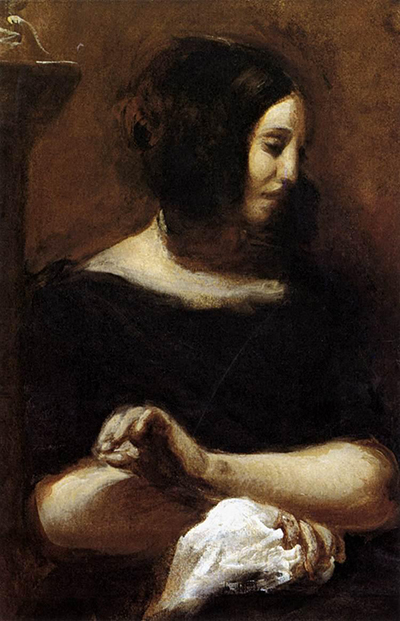This portrait of George Sand shows her sewing in a relaxed setting. It was part of a much larger composition which included Frederic Chopin stood by a piano, but both portraits were later cropped out and the remaining items disposed of.
Portraiture is not a genre that dominates Eugene Delacroix's oeuvre, even though he was particularly well skilled at it. Normally his ability to depict the human form can be seen in his larger compositions, where many different figures would be found together. The original composition was larger and captured the two figures within an indoor setting, perhaps a music room or study. George Sand, the woman's pen name, was known to enjoy sewing whilst listening to music, and so one can imagine this set up actually happening in reality. She was a talented writer but perhaps felt that a male pen name would give her a better chance of getting her work published and promoted, such was the state of society at that time, right across Europe. Thankfully, she was later discovered to be the mind behind some respected literature and she is now celebrated under her real identity.
A recent artist's impression of what the original looked like has been created in order to help us better understand how things initially looked. That composition is fairly dark in tone, leaving the two figures as the single interest. It may have been that these two portraits were completed first and that the rest was left incomplete, leading to the decision to cut them out and store them separately. Light is also very carefully exposed within both portraits, allowing the eye to be focused on the two individuals, with everything else purposely reduced in the hierarchy of importance. One could see the same with earlier pieces from Rembrandt (Night Watch, Return of the Prodigal Son), Caravaggio (The Conversion of Saint Paul, Crucifixion of St Peter) and in a more subtle way, Titian too. Delacroix's own use of light was also sometimes much more blended and softer, which would help to inspire the Impressionist movement that followed on after his own career.
Whilst the two original components of this double portrait will never achieve the same fame as Delacroix's more famous paintings, such as Massacre at Chios and Barque of Dante, they offer more reminders of the artist's qualities in portraiture. He mastered almost all technical challenges that he came up against, across a wide range of artistic genres, but was most attracted to the emotional themes that could be delivered from inspiring items of literature. He was very much a Romanticist naturally, though he also produced a good number of works within the Orientalist movement which came from his time travelling around North Africa. He also travelled to the UK for a period as well, growing into somewhat of an anglophile, having gained so much from their contributions to Romanticist poetry.




